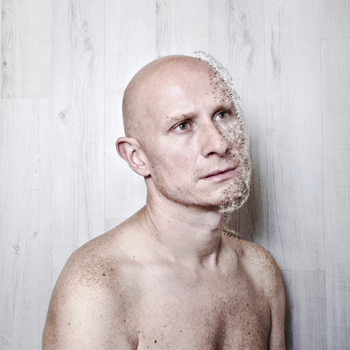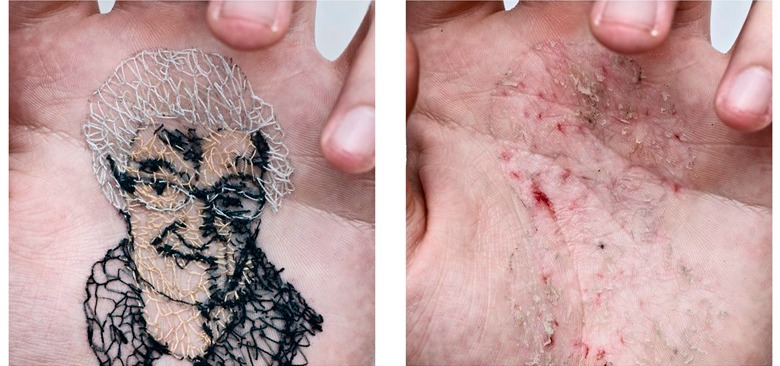And it’s not just us — the 200,000+ view count on Catá’s Vimeo channel speaks for itself. Yet despite all this recognition, Catá is extremely shy… or is it because of this? In order to find out more about him, we invited Catá to join us on a crisp autumn morning in Madrid. We’re happy to say that he agreed…
Like many young artists, David Catá, the 27 year old from Vivero (Lugo), dreams of making it one day in the Big Apple. But in the mean time, he’s following in the footsteps of many artists before him by moving to Madrid in the hope of establishing himself as an artist. However, we at BritEs think that he has something which makes him stand out from the crowd.
And it’s not just us — the 200,000+ view count on Catá’s Vimeo channel speaks for itself. Yet despite all this recognition, Catá is extremely shy… or is it because of this? In order to find out more about this self-confessed Beethoven fan and lover of Lars Von Triers movies, we invited Catá to join us on a crisp autumn morning in Madrid. We’re happy to say that he agreed…
You describe your work as being “objects of intervention”. Could you explain this?
What I do is collect personal objects such as photo IDs and family albums and work with them, often adding things to them and intervening. In all my work, I take a subject which is usually something transient, and then use it to create a metaphor.
The subject of your family and roots is a very prominent feature in your work. How much importance do you give them?
Well, two recurring themes in my pieces are memory and the passage of time. I became obsessed with these ideas, especially as I entered my teenage years but the problem was that I had no way of channelling my thoughts. That all changed when I started touching upon them in my work.
These thoughts were born out of the conversations I would have with my great-grandmother when I was 13. She was extremely superstitious and believed in the witchcraft and spirits. She told me that I attracted spirits whenever I looked in the mirror and used to spook me with stories about my family and ancestors which would often go around and around in my head. I needed some way of getting rid of them which didn’t involve telling other people about them. It wasn’t really something I could talk about with my friends. And so, I addressed these thoughts using photography, and without realising it, I saw that the same concerns kept coming up.

Let my fly II, 02. 2012 © David Catá
‘Let me fly’, ‘Under my skin’, ‘Neither with you nor without me’. Another feature of your work is that you are always present. Is your presence a necessity?
Yes, it’s certainly true that I am present in each piece. Even when you can’t directly see it, I make myself present through the people I photograph. I’m constantly using other people to make self-portraits of myself and so, you could say that I am there in the piece even when I don’t actually appear. If you consider how all my work is personal to me and that I’m dealing with my own thoughts and concerns, I’d say that yes, my presence — whether direct or indirect — is necessary.
Can we say then that each piece of work is like a new chapter in your life — that you are showing us more and more about yourself?
That’s right and it’s something I do without even realising. I relate each episode of my life to a different subject, which I then use as a way of dealing with any concerns I have at the time. For example, my projects working with thread correspond to a very difficult time in my life when I was addressing some sensitive issues in my family. At that time, I was reflecting on the effect that a family has on the individual and how I felt as if my own family had left a mark on me… So I took the thread, which I see as symbolising the thread of life, and used it to communicate the way in which a family binds people together.
There was also an earlier project where I used ice to express our futile attempts at preserving the identity of others. I did this by freezing photographs and then recording how the faces became completely distorted by the ice. I then superimposed the parts that remained unfrozen with wrinkles, taking photos then of what the people looked like in reality. These wrinkles represented the passage of time and that despite the faces being frozen in time, life keeps marching on…
From what you’re saying, it seems that you bear your entire heart and soul to us and leave nothing unexposed. This is certainly the case in your latest project where you expose yourself in a more physical way…
That’s my Berlin project. In that piece my subject is ash and how it represents the end of something… in this case, the end of my time spent living in Berlin. The project was inspired by the ash from the old coal-powered boiler which heated my house. The scene is filmed in my house. That’s to say, like the end of a stage, my journey, moving and returning to my hometown in Galicia.
At the moment, I’m also working on another project about this idea of returning to my roots. I arrived back in Galicia right at the time when my grandfather’s house was being sold and with it, so many family memories. I’m currently using my grandparents’ bedroom which I’m filling with roots…
Catá during the interview © Pablo Conejo
After seeing one of your performances like the one where you sew a portrait onto your palm in front of a stunned audience, you can’t help wondering where the line is between being provocative and just trying to shock for the sake of it…
That’s an interesting point. I wouldn’t describe myself as provocative… or maybe I am! (laughs). The truth is… that whenever anyone asks me if it hurts, I always tell them that it looks much worse than it really is. I know that my performances can leave people feeling queasy or disgusted, but the point of it is definitely not to give any importance to the pain involved. My work, after all is not about physical pain but emotional pain.
When I did my first palm portrait, I had a very clear idea of how I wanted my work to be, but then I’d tell myself: ‘you’re not really going to go through with this… your hand has more holes in it than a sieve!’ I didn’t want to go through with it. After all, I am a very shy person and I don’t like to feel like I’m being judged.
So you were worried about what other people might think? A bit. Like I said, I’m very shy. But when I made my next portrait the following week, I told myself that it doesn’t matter what other people think and just went for it…
But you don’t strike us as your average shy person, considering the way you jump so easily from one extreme to another.
True, but I must add that I did those it more out of necessity than anything else. But when the video went viral, that was really crazy! It actually made me quite uncomfortable because the public started to demand work from me on their watch and not mine. And I only did what I felt. Initially I began doing various public performances. I didn’t mind doing them at all but then it got to the point where people were demanding the performances not because they were interested in the meaning behind it, but just for the shock-factor of ‘the guy who sews stuff on his hand’. That’s when I started to lose interest in the whole thing… I didn’t want that, so I stopped. Sure it’s publicity, but it’s not the kind of publicity I’m after. That kind of publicity doesn’t reflect my ideas or anything I’m trying to express but instead focuses solely on the superficial part of the project. I don’t like that kind of exposure.
But there is a good type of exposure… one that you like?
Yes, the kind that actually showcases my work and stimulates the public or inspires them in some way. I like that kind of exposure, where the meaning doesn’t go unnoticed.
Winged roots, 04. 2014 © David Catá
You once declared that we should not be limited by physical pain. What would you say are your limits… if you have any?
Of course I have limits! (laughs) When I said that, I was referring to the people you accused me of self-harming… but I didn’t see it like that. What I was doing was making a statement about how pain will not get in the way of what I wanted to achieve.
To finish, I won’t ask you to make the difficult choice of deciding your favourite discipline to work with… I’ll ask you something even harder. Which work would you pick for your Wikipedia page? Which piece best defines you?
That’s a tough one! (pauses) ‘A flor de piel’ certainly has a place very close to my heart because it represents all the people that are important to me. It’s been over 6 months since I last worked on that piece, but I want it to be a life-long project.
That said, I think my personal favourite is the portrait of my great-grandmother* because she’s the one who started it all.
* this is the image we chose as the cover photo for the article
[su_note note_color=”#eaeae9″]Translated by Danny Concha [/su_note]
———————————
David Cata’s Website: www.davidcata.com
Acknowledgment: Gau & Café y Roll Madrid

